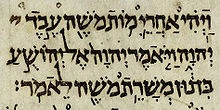|
|
| |
|
|
| |
|
|
|
|
| |
 |
| Aleppo Codex: 10th
century Hebrew Bible with Masoretic pointing
(Joshua 1:1). |
Hebrew
The Hebrew language is a Semitic language. It is the
language of the Jews. The Academy of the Hebrew Language
is the main institution of the Hebrew language.
The language was spoken by Israelites a long time ago -
during the time of the Bible. After Judah was conquered
by Babylonia, the Jews were taken captive to Babylon and
started speaking Aramaic. Hebrew was no longer used as
much in day-to-day life, but it was still known by Jews
who studied religious books. |
|
In the 20th century, many Jews decided to make Hebrew
into a spoken language again. It became the language of
the new country of Israel in 1948. People in Israel came
from many places, and decided to learn Hebrew, the
language of their common ancestors, so they could all
speak one language. However, Modern Hebrew is quite
different from Biblical Hebrew, with a lot of simplified
grammar and loanwords from other languages, especially
English.
In order to read the Bible in its original language, one
must learn Biblical Hebrew, Biblical Aramaic and Koine
Greek. |
|
Hebrew is a lot like the Arabic language. Hebrew words
are made by combining a root with a pattern. In Israeli
Hebrew, some words are translated from European
languages like English, French, German, and Russian.
Many words from the Old Testament were given new
meanings in Israeli Hebrew. People learning Hebrew need
to study the grammar first in order to read correctly
without vowels. In Israeli Hebrew, there is no verb "to
be" in the present tense, only in the future and the
past tenses. In Biblical Hebrew, there are no tenses but
only two "aspects": imperfect and perfect. The imperfect
is something like the future and the present tenses. The
perfect is something like the past tense. Mishnaic
Hebrew is the Hebrew spoken as well as Judeo-Aramaic in
the time of Jesus and in the time of the Bar-Kokhba
revolt (2nd century AD), until the Byzantine Empire of
Justinian (6th century AD).
The Hebrew alphabet has been adapted to write Yiddish,
another of the Jewish languages. But Yiddish sounds
different from Hebrew as it comes from the same family
as German. |
|
Alphabet
The Hebrew alphabet has 22 letters. Five of these
letters change when they are at the end of a word. The
Hebrew language is read from right to left. The Hebrew
alphabet is an abjad which means that only the
consonants are written out and the reader must supply
the vowels himself. Since this is pretty difficult, the
vowels can be marked as dots called niqqud (plural
niqqudim). In Modern Hebrew, some letters can denote
vowels. These are called matres lectionis (mothers of
the reading) as they help the reading a lot. |
|
|
 Kiddle: Hebrew Kiddle: Hebrew
Wikipedia: Hebrew |
|
|
|
|
|
|
|
|
|
|
|
|
|
|
|
|
Search Fun Easy English |
|
|
|
|
|
|
|
|
|
|
|
|
|
|
|
About
Contact
Copyright
Resources
Site Map |